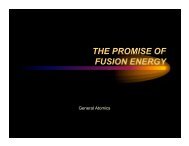Workbook: Fusion Natures Fundamental Energy Source - General ...
Workbook: Fusion Natures Fundamental Energy Source - General ...
Workbook: Fusion Natures Fundamental Energy Source - General ...
You also want an ePaper? Increase the reach of your titles
YUMPU automatically turns print PDFs into web optimized ePapers that Google loves.
<strong>Fusion</strong> <strong>Workbook</strong><br />
E<br />
l<br />
e<br />
c<br />
t<br />
r<br />
o<br />
m<br />
a<br />
g<br />
n<br />
e<br />
t<br />
i<br />
c<br />
S<br />
p<br />
e<br />
c<br />
t<br />
r<br />
u<br />
m<br />
1. Another name for infrared is:<br />
a) visible<br />
b) UV<br />
c) heat<br />
d) wavelength<br />
2. An angstrom (Å) is a unit of<br />
wavelength equal to<br />
a) 1 micron = 10 -6 m<br />
b) 1 m<br />
c) the distance between the sun<br />
and earth<br />
d) 10 -10 m<br />
3. 1 mm is a wavelength found in which<br />
portion of the electromagnetic spectrum?<br />
a) infrared<br />
b) microwave<br />
c) visible<br />
d) ultraviolet<br />
4. The electromagnetic spectrum represents:<br />
a) a classification scheme for radiation<br />
wavelengths and frequencies<br />
b) a narrow portion of visible light<br />
c) energy transfer between<br />
chemical bonds<br />
d) an electrician’s guide to high voltage<br />
5. A wavelength of visible red light is<br />
a) 1 mm<br />
b) 10-6 m<br />
c) 7000 angstroms (Å)<br />
d) 600 angstroms (Å)<br />
http://<strong>Fusion</strong>Ed.gat.com<br />
22<br />
6. Ultraviolet light is energy that:<br />
a) can be felt as heat<br />
b) can be harmful to DNA<br />
c) is emitted by an X-ray source<br />
d) has a wavelength of 1 Å<br />
7. The most penetrating radiation to<br />
human tissue is:<br />
a) x-ray<br />
b) ultraviolet<br />
d) infrared<br />
e) visible<br />
8. The colors which are visible to<br />
our eyes:<br />
a) are a small part of the<br />
electromagnetic spectrum<br />
b) are between infrared and ultraviolet<br />
in the electromagnetic spectrum<br />
c) have wavelengths between<br />
4000 Å and 7000 Å<br />
d) all of the above<br />
9. In a vacuum, electromagneti<br />
waves travel:<br />
a) at the speed of sound<br />
b) slower than in water<br />
c) at the speed of light<br />
d) in the direction of the magnetic field<br />
QTYUIOP




